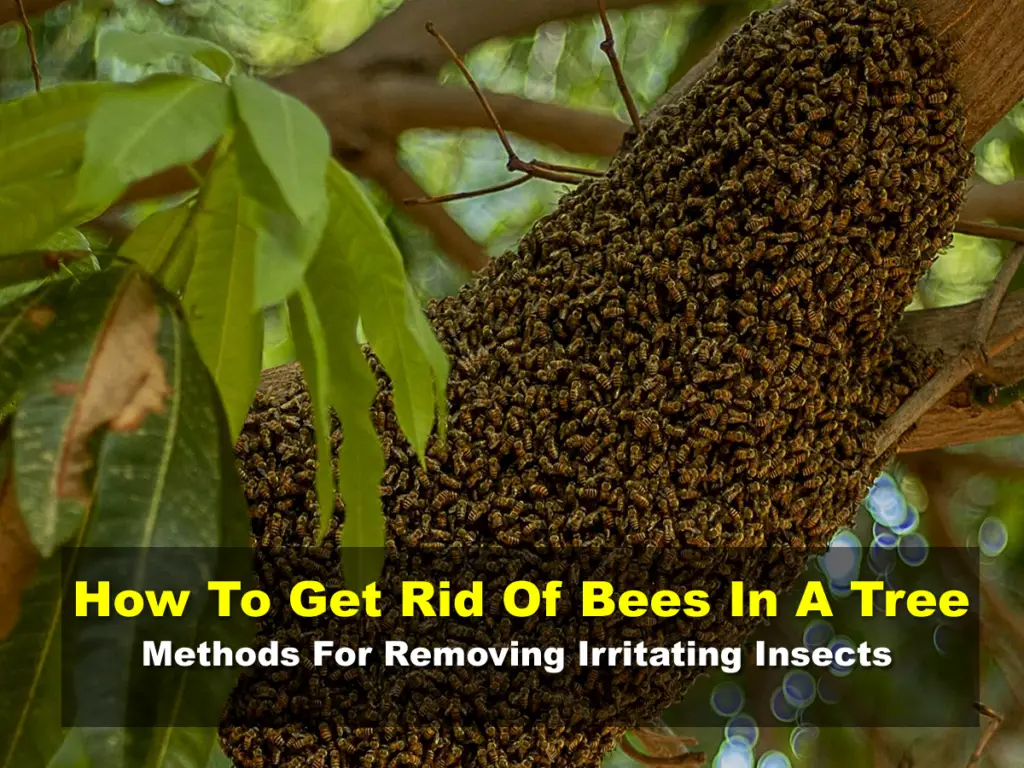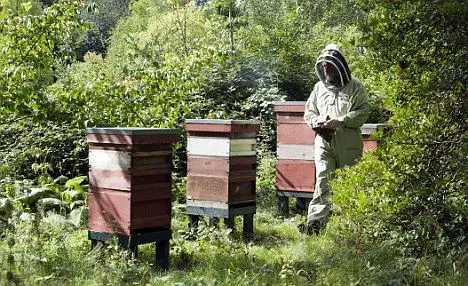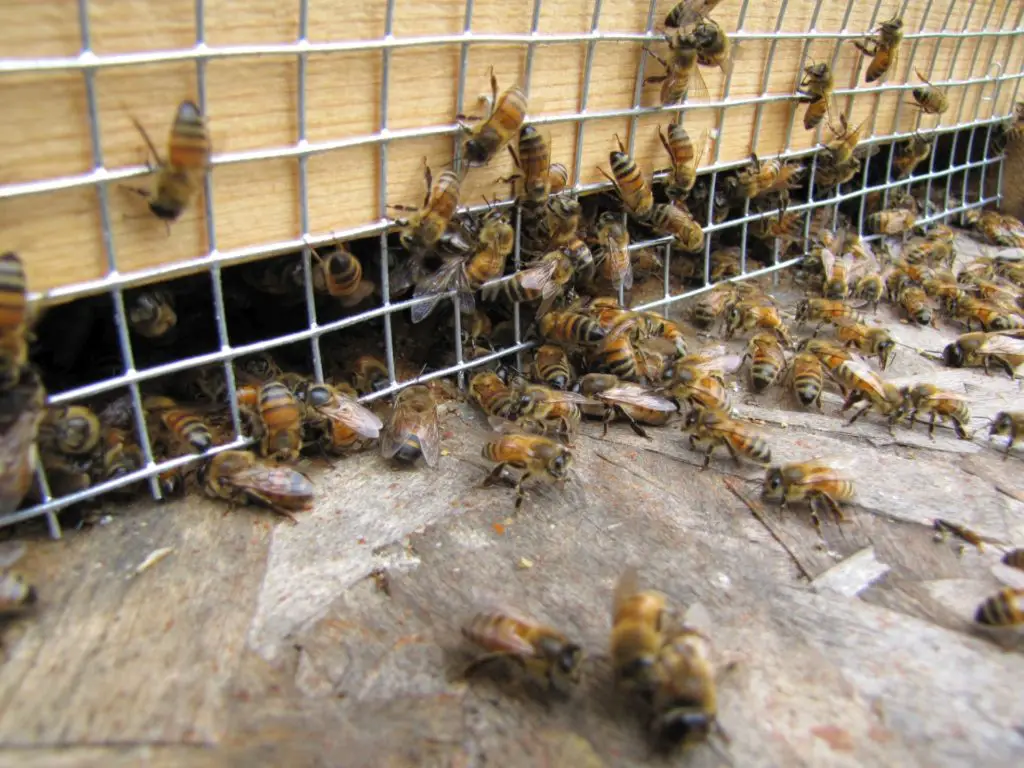Affiliate Disclaimer - As an Amazon Associate I earn from qualifying purchases.
It supports the website. So, Thank you
For shade, privacy, and aesthetic appeal, trees have a lot of uses in the garden. However, they also serve as a home for many insects and animals so having a lot of trees isn’t without its problems.
For example, some species of bees love to nest in and among the branches, leaves, and bark. If this happens in your backyard, it’s important that you understand how to get rid of bees in a tree.
The two best methods for getting bees out of a tree include setting up a trap out or forcing the bees to leave. However, where possible, it’s best to leave the bees where they are as long as they’re not hurting anybody.
In this post, I’ll explain these methods in greater detail so you can have a bee-free garden and enjoy the summer in peace.
Table of Contents
What Types Of Bees Nest In Trees?
There are over 20,000 species of bees on planet Earth and each has its own preference when it comes to nesting.
One of the most common types of bees that you’ll find inside a tree is the carpenter bee and there are generally two varieties that are likely hiding in your garden greenery. These are the yellow and black carpenter bee and the green carpenter bee.
However, you may also find various species of honey bee and bumble bees nesting in trees as well as some species of stingless bee.
The good news is that all of these species are harmless to humans which is why I always say that they should be left alone unless they’re causing a nuisance. You may also wish to eradicate a bee’s nest if you’re allergic to bee stings.
While these bees (not including stingless bees as they’re unable to sting) will only sting when they feel threatened, it’s not worth the risk to your health.
I’d also like to point out that a nest is different from a swarm. Honey bees, in particular, will swarm when their colony gets too large. A huge group of bees will gather together in a cluster and head off in search of a new home.
Flying takes its toll so the swarm sometimes needs to rest and it’ll often do this while hanging from a tree branch. However, when bees nest in a tree, they’ll typically do it inside the trunk or branches where there’s a good level of protection from the outside world.
What Types Of Trees Do Bees Nest In?
If carpenter bees are a problem then you’ll probably be looking at dead trees as the wood is easier for them to burrow into and there are often hollows already present.
However, bees are attracted to trees that produce a lot of pollen and nectar such as fruit trees, willow, acacia, and maple.
Imagine being able to build a home and have a food source directly outside; that’s what bees are looking for when they choose a nest site.
That said, it is possible to find bees in many other types of trees so if you don’t have the above mentioned species in your garden, that doesn’t mean you’re exempt from having some winged guests.
Finding The Entrance
If you’ve noticed a lot of bees buzzing around the trees in your garden then you may be suspicious that there is a nest. However, this isn’t always the case. It could simply be that the flowers produced by the tree are attracting a lot of flying visitors.
Before you assume the worst, I’d recommend inspecting the tree to see if you can find the entrance to a nest. An obvious opening within the tree is the first thing to look for, especially if there are lots or bees going in and out of it.
It’s also worth noting that some species, like honey bees may build their nest structure outside of the tree and it’ll typically be hanging from the branches. However, for the purposes of this article, I’m going to focus on an internal nest.
Methods For Getting Rid Of Bees In A Tree
I’ve written many guides in the past on how to get rid of bees but these methods aren’t always as effective when it comes to nests in trees. That’s because of the established structure of the nest so it’s often easier to use one of the following practical extraction methods.
Trap Outs
A trap out is a common technique used by beekeepers and professional pest controllers. The great thing about it is that it’s completely natural so won’t cause any harm to the bees. The only real problem for them will be finding a new home.
You’ll need to start by inspecting the tree not only for the main entrance but any additional smaller entrances to the nest. For each one you find, you’ll need to fill it using a material that the bees won’t be able to take back out. Something like plastic or foam works very well.
Next, you’ll need some steel mesh. It’s important to choose mesh with the right sized holes as you’re going to place this over the openings to the nest, allowing the bees to get out but preventing them from getting back in. Usually ½ mesh works well.
Take the mesh and shape it into a cone, placing the narrow end at the entrance of the nest. The bees will be able to come out but they have a very hard time getting back in.
You could leave things like this and wait for all of the bees to come out but this could take a considerable amount of time. Instead, it’s much easier to place a lure just outside the entrance that’ll capture the bees’ attention and draw them out. Something as simple as sugar syrup will work wonders.
Keep checking back to ensure that the bees are coming out but cannot get back in. If they’ve got another entrance that you didn’t notice in the first place, you’ll need to seal this as well.
This method could take some time and patience but it is effective. Once you’re sure that all of the bees have left, I’d recommend keeping an eye on the tree to make sure that no further infestations occur.
Forcing The Bees To Leave
Another way to get rid of bees from a tree is to perform what beekeepers call a forced abscond. Again, this is ideal if you’re looking for a method that isn’t going to harm the bees. However, it does require some specialist equipment such as a bee smoker and a drill. What’s more, this method requires a little knowledge about the structure of a bee’s nest so I’d only recommend this if you’re clued up.
If there is a clear entrance to the nest then begin by setting up a trap out as I described in the previous section. If not, you’ll need to get a bit more hands on.
To start, you’ll need to locate where the honey stores are within the nest and this can be done by using a ¼ inch drill bit to make a hole in the tree. You’ll then need a small camera which you can insert into the hole and use to look around and locate the honey source.
You can then widen your initial hole to around ¾ inch and use a bee smoker to blow in a few puffs of smoke. This will allow the bees to start eating some of the honey which will be beneficial for them after they leave.
Continue smoking until you start seeing the bees leaving the nest through the main entrance. Usually, this doesn’t take too long as they won’t be keen to remain inside with all that smoke.
Since you’ve set up a trap out at the entrance, they won’t be able to get back in. I’d recommend continuing to smoke the nest until no more bees are leaving. However, don’t just assume that all is well at this point as there may still be some stubborn individuals hiding inside.
For this reason, leave your trap out where it is for at least another 24 hours. You can then come back and check the nest and, if everything is clear, go ahead and seal up the entrance.
Should I Use Bee Killer?
One of the last things I would ever recommend is to use a bee killer spray, dust, or any other product. The only time that this would be acceptable is when the bees pose a serious risk to human health or where every other attempt at removal has failed.
Bees are among some of the most important pollinators on the planet and their numbers are already dwindling. We don’t need to encourage their demise.
For the most part, bees are pretty harmless and will only sting if they feel threatened. Killing them is doing nobody any favors.
However, if you need to use a chemical insecticide then it’s essential to follow the manufacturer’s instructions to the letter. If you’re in any way unsure, it might be best to contact a professional pest controller.
Final Thoughts
During summer, I have a lot of people ask me how to get rid of bees in a tree. Trees are a popular nesting spot for bees and it’s not uncommon for a large colony to set up home right there in your prized backyard willow.
But most people don’t want to share their outdoor space with bees. Fortunately, there are a couple of methods that will effectively get rid of those bees so you can enjoy your garden in peace.




